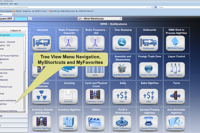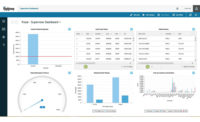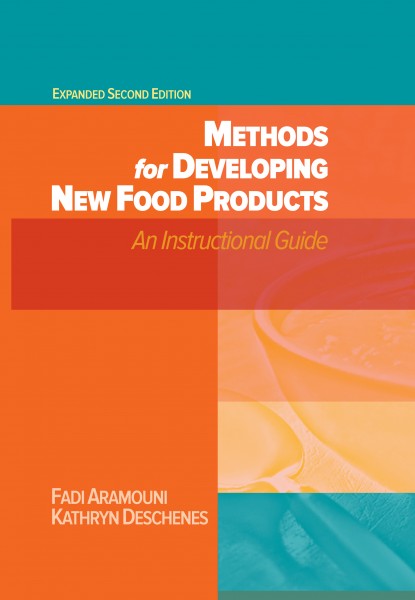3PL Software Supports Brisk Expansion

Ranked 10th among North American refrigerated warehouse firms and in the Top 15 worldwide, Cloverleaf Cold Storage, Inc. continued its aggressive program of expansion in the U.S. Southeast in 2011 with the acquisition of Imperial Freezer Services, a modern 3.5-million-cubic-foot facility in central North Carolina that is oriented toward poultry, but handles pork and beef as well.
expansion in the U.S. Southeast in 2011 with the acquisition of Imperial Freezer Services, a modern 3.5-million-cubic-foot facility in central North Carolina that is oriented toward poultry, but handles pork and beef as well.
Cloverleaf has been building out its controlled temperature and dry storage capabilities since its reinvention in the late 1950s, when it reached outward from origins in farm produce and began a march toward leadership as a third-party logistics provider specializing in refrigerated warehousing.
What is striking is the ease with which Cloverleaf brought Imperial’s warehouse management and workflow operations into compliance with those of the company’s other 14 locations, some of them sites with multiple buildings. All are controlled centrally using Accellos One Enterprise 3PL third-party logistics management software residing on a server at its Sioux City, Iowa, headquarters.
With meticulous advance planning—extracting data from the existing software, creating new storage locations and warehouse processes and applying new numbering and code conventions in the Accellos software—the Cloverleaf team was able to upload the inventory records and bring the new facility on board on a single weekend.
“It was relatively easy,” says Curtis Mastbergen, vice president of administration and finance. Mastbergen has done this numerous times before, including when the company acquired three other facilities in the Southeast in 2010. “Using the MOCO (modify conversion data) program residing within the Accellos software, it can all be done in a spreadsheet. We use a standard set of Excel templates, save the data as a file, import it to Accellos, validate the data and we’re ready to process.”
Who is Cloverleaf Cold Storage?
Cloverleaf’s history traces to 1934, when it originated in Sioux City, Iowa, as Farmers Produce Co. It expanded into freezer services first in Mankato, Minn., in 1952 and soon, to a similar operation in Sioux City. Today, it operates more than 63 million cubic feet of warehouse space—an increase of approximately 50% between 2006 and 2011—most of it freezer/temperature controlled.
The company adopted Cloverleaf Cold Storage as its corporate name in 1958, but revived the Farmers Produce identity in 1988 to broaden its capabilities for cutting, processing and packing. Farmers Produce’s focus is on handling raw protein products and strategically positioning or acquiring facilities close to concentrations of beef, pork and poultry production.
Besides the raw protein products, the company also handles a variety of other edibles, including ice cream, donuts, French fries and egg products as well as “not human consumables” and some non-perishables.
Currently, Cloverleaf has operations in seven states—Cherokee, LeMars and Sioux City, Iowa; Fairmont and Lakeville, Minn.; Chillicothe, Mo.; Columbus, Fairfield, Massillon and Napoleon, Ohio; Chesapeake, Va.; Sanford and Benson, N.C.; and Sumter, S.C. Mastbergen estimates that the company has more than 500 unique clients, with sites serving anywhere from 25-125 customers, some of them customers at multiple facilities.
Services vary from warehouse to warehouse, including, among others, basic freezer, cooler and dry storage, blast and room freezing, product tempering, import/export services, cross docking, custom fabrication and packing (Farmers Produce), and a portfolio of documentation services for both domestic and export operations. Cloverleaf built the industry’s first rack-supported warehouse; it was among the early adopters of push-back racking and has been an active EDI user since 1989.
Technology
Cloverleaf Cold Storage manages its sprawling warehouse complex with Accellos One Enterprise 3PL third-party logistics management software, in place since 2004. It manages the business side of the corporation with a Microsoft Dynamics GP ERP solution that is seamlessly integrated with the Accellos software.
“Accellos’ concentration on the 3PL cold storage market has given them an extraordinary, in-depth awareness of the field and its challenges, and that is one of the primary reasons we selected them as our 3PL management solution,” Mastbergen says. “We wanted an expert in our field, not a vendor to whom cold storage was a sideline.”
Accellos One Enterprise 3PL is a modular logistics management solution that integrates all of the management activities of a multi-client warehousing operation, incorporating concurrent multi-client workflow processes, customer on-demand self-service, labor planning and automation and revenue management. It also allows companies to establish and monitor minimum warehouse operating standards.
The 3PL system communicates seamlessly not only with the Microsoft Dynamics GP solution, but also with auxiliary modules, including the EDI/XML translation middleware, with Accellos’ own d’Amigo alerts utility and with its eVista online customer visibility tool. The combination enhances productivity, supports management practices and enforces client requirements across the entire range of receiving, warehousing and shipping processes.
The d’Amigo utility can be set for a virtually open-ended number of customer and Cloverleaf inventory condition notifications and alerts. eVista allows warehouse customers to view the status of their inventory online 24/7, providing them with easy access to their vital information while dramatically reducing Cloverleaf’s customer inquiry response load.
The software complex resides on a server situated at corporate headquarters in Sioux City and is linked to the warehouses via a wide area network (WAN) administered by End2End, an Accellos communications technology partner based in Toronto, Canada. Within the warehouses, 802.11 wireless networks funnel information between the floor and the 3PL software using Psion handhelds and Motorola vehicle-mounted computers to facilitate fast, accurate receiving, put-away, picking, packing, transferring and processing operations.
EDI functionality
Some 60% of the company’s transactions with customers are conducted via electronic document interchange, with both inbound and outbound documents translated automatically by the middleware. Cloverleaf can trigger EDI uniquely from any point in the workflow.
Cloverleaf’s customers employ a variety of electronic document communications formats, including ANSI X.12 EDI, XML and flat file. No matter the format in which a customer document arrives, it is converted automatically for reception into the Accellos system, with Accellos handling all of the business logic thereafter for whatever further action is required. Similarly, the Accellos software automatically pushes out the appropriate EDI document at the right time for conversion into whatever format is required on the receiving end.
EDI transaction sets in use by Cloverleaf include the Warehouse Shipping order (940); Warehouse Shipping Advice (945); Warehouse Stock Transfer Receipt Advice (944); Warehouse Stock Transfer Shipping Advice (943); Warehouse Inventory Adjustment Advice (947); Shipping Notice/Manifest (856); and Inventory Inquiry Advice (846).
“The standard forms are the starting point used by most of our EDI-enabled customers,” Mastbergen says, “but frequently they ask us to modify or extend them to accommodate unique preferences. One of our principals, David Kaplan, heads the EDI effort and our team can render these forms exceptionally powerful, significantly affecting ROI and overall efficiency.”
Implementation
The rapid implementation of the Sanford site is an example of how the Cloverleaf technology team’s process works.
“Initially, we conduct interviews with the existing staff to learn how they’ve being doing things,” Mastbergen says. “We go through a similar set of questions for each customer. Then, we create a conversion plan with this information.”
An entire facility can be built or converted in about six steps, he says, much of it done using Accellos system tools to make the code conversion, along with Excel spreadsheets. The six steps include:
1. Load all locations: aisles, bins, levels
2. Build customer records (import or key-in)
3. Build customer's items (important to import; otherwise too much keyboard work)
4. Export the inventory and location records from the legacy system into an Excel spreadsheet
5. Massage the inventory records to meet Accellos and Cloverleaf specifications
6. Upload the inventory balance file and validate the data.
“In the course of the conversion, we insert the data into the locations that we’ve built into the spreadsheet, and once we validate and process it, it creates a new Accellos One Enterprise 3PL record,” Mastgergen adds. “The Accellos software offers a variety of useful conversion templates for items, locations, customers, shippers and consignees.”
At the spreadsheet stage, the data can be manipulated, if necessary—for example, to change the way bin labeling is represented in the software.
“This might involve the use of numbers versus letter codes,” Mastbergen says. “Or, a company may have opted not to use the full number of letters or digits in their bin codes. We can make these adjustments in order to make the respective physical conditions conform to our inventory processes in the Accellos software.”
The whole process is relatively easy, he says, and it enables the company to bring new customers on board quickly and easily. Not an import process, it uses programs within the Accellos software to build the customer records, initially including name, address, type and length of storage periods, with the actual inventory item data then loaded as product arrives.
“Some customers can be set up in just a few minutes,” Mastbergen says. “The Accellos software allows us to create standardized workflow processes in which we can select values for specific fields, picking pieces for such activities as flow, pick profiles, EDI and so on.”
Frequently, the implementers simply select building blocks from a list already existing from previous implementations. In one-off cases, new profiles may need to be configured, but Cloverleaf leans heavily in the direction of previously built, selectable profiles. To Mastbergen, it is all about being consistent across the organization and customer base.
Workflow
The warehouses for the most part feature standard racking, specified primarily in relation to its intended use—for example, to store raw protein products versus the market-ready products. Bin identification typically follows a company-wide protocol—letters for aisles; numbers for bays; odds on the right; evens on the left; with letters again used for racking levels.
Customer inventory arrives at Cloverleaf plants in a variety of ways—by truck, usually palletized; and by rail car and container, usually floor-loaded or on slip sheets. Product originating in adjacent production facilities is transferred by fork lift, normally palletized as well.
Upon arrival, product is checked in blind in order to assure accurate, verified counts, followed by an Accellos-directed blind count put-away process in which workers are provided with assigned aisle/rack/bin locations via their barcode-enabled RF guns. At put-away, they again use the RF devices to confirm the match-up between the pallet I.D. and the respective bin location, completing the record in the Accellos software over the wireless network and on to the central server in Sioux City.
Barcode labels are critical to virtually all of the warehousing activities, and the Accellos software can produce them if an inbound shipment doesn’t have them. The receiving operations also set the stage for billing, in-house reporting and renewal storage billing.
Outbound orders arrive from warehouse producer-customers only, most by EDI, the balance by phone, fax or paper document and are keyed in to Accellos One Enterprise 3PL so that the rest of the process can be executed using the RF guns. Most EDI orders are shipped at the skid/pallet level, intended for delivery to distributors or to Cloverleaf customers’ large accounts. Other orders can be more varied, down to the case or each level.
Orders for inventory items intended for restaurants, foodservice operations and retail outlets can present other fulfillment issues—examples include dry produce, paper goods, case and each goods as well as mixed temperature loads.
“A restaurant might want a single 2.5-gallon container of mayonnaise rather than a full case of six,” Mastbergen says. “We would break out the case and send the single unit.”
Pick patterns—serpentine, up-down aisle, etc.—are organized around the aisle/bin/rack identification scheme. Usually, they are set up to accommodate customer needs, with put-away organized around the pick pattern in place. Heavy picks may not follow a pick pattern at all. The RF guns are also used to confirm loading, and many shipments also require scan weights to be recorded—inbound, outbound or both.
The Accellos software automatically generates all of the required shipping documents as dictated by the workflow configuration.
Results, conclusions
Cloverleaf has a full range of certifications, including from the USDA for its storage-only warehouses and for Farmers Produce, with its emphasis on fabrication and packaging. Much of its export business is done with Russia, and holds their government’s various approvals and certifications. The Chicago Mercantile Exchange has designated it an approved warehouse, and the company maintains its own U.S. Customs Container Freight Station.
Having implemented the Accellos software in both newly constructed and acquired facilities over several years, Mastbergen and his information technology team have developed in-depth familiarity with the system at every level.
“When we make this kind of investment,” he says, “we want to get the most out of it, and we do. We use nearly every part of it.”
In the face of strong competition and constantly shifting customer needs, the Accellos system helps Cloverleaf maintain productivity and profitability. For example, by using applications within Accellos, such as count-back in conjunction with picking orders, Cloverleaf keeps customer inventory records current, up-to-the-minute. The company has thus been able to greatly reduce the need for cycle counts and inventory control staff.
Efficiency, a paramount consideration, is maintained at a consistently high level, with accuracy never a problem since the software enables precise inventory record maintenance. Changes are easily accommodated and dealt with—for example, one phase of the business used to require only four steps, where it now requires seven, Mastbergen notes.
“Nevertheless, we must adhere to regulatory changes and do what our customers need while sustaining profitability because the pay is normally the same,” he adds.
“Cost was never the main consideration in selecting Accellos,” Mastbergen says. “We are concerned with capability and return on investment, and feel that Accellos One Enterprise 3PL’s flexibility and power more than justify its pricing. We take advantage of its capabilities in depth, and this has enabled us to serve our clients accurately and efficiently even as their service and competitive requirements continue to grow. We win a lot of customers with needs that our competitors can’t handle. Accellos One Enterprise 3PL is a big part of that.”
Looking for a reprint of this article?
From high-res PDFs to custom plaques, order your copy today!







